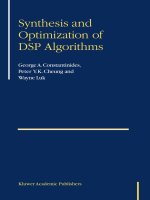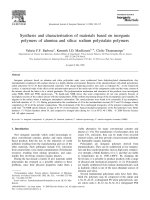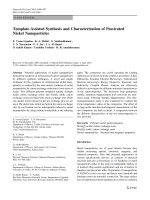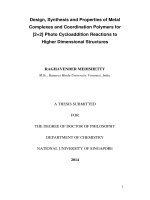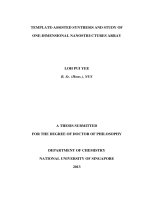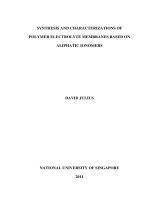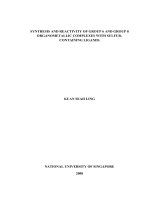Template assisted synthesis and assembly of nanoparticles 5
Bạn đang xem bản rút gọn của tài liệu. Xem và tải ngay bản đầy đủ của tài liệu tại đây (3.03 MB, 40 trang )
Chapter 5
Chapter 5 MWCNT/PbS and aligned MWCNT/PbS
nanocomposites
In the previous two chapters we reported the preparation of homogeneous
PANi/Ag
2
S and clay/PbS hybrid nanocomposites by decomposing silver or lead
precursor within the matrix directly. In other cases, however, semiconductor
nanoparticles can also been attached onto the sidewalls of one-dimensional (1D)
nanomaterials, such as nanotubes and nanowires to form another type of
nanocomposites. Using 1D nanomaterials as the basic building blocks, various classes
of nanocomposites have been explored.
1, 2
Carbon nanotubes (CNTs) have unique
structure and remarkable mechanical, electrical, magnetic, and photonic properties
etc
3
. The small diameter (in the scale of nanometers) and the length (in the order of
microns) of CNTs lead to such high aspect ratios that CNTs is now the most
promising and ideal 1D systems.
A combination of unique properties of CNTs with semiconductor nanoparticles
opens up the potential to use CNTs for various advanced applications such as
quantum wires in heterojunction devices, reinforcing materials in composites,
nanoprobes in an AFM, and catalyst support in heterogeneous catalysis. Wildgoose
and coworkers
4
reviewed all electrochemical methods that were used to prepare metal
nanoparticles supported on carbon nanotubes and illustrated the electrochemical
applications. Another detailed review given by Georgakilas and coworkers
5
reported
that the composites of CNTs with nanoparticles can be achieved through two main
153
Chapter 5
pathways. One way is that naked NPs are grown and/or deposited directly onto the
CNT surface. In an alternative approach, NPs are preformed and connected to CNTs
using covalent linkage through organic fragments
6, 7
.
In most cases, functionalization of the side wall of CNTs is required so that
nanoparticles can be attached through covalent or non-covalent bonds. During the
attachment of compound semiconductor nanoclusters via covalent linkages, and the
anchoring of metal complexes to oxidized nanotube surfaces, CNTs were treated with
harsh acidic processing. Such harsh conditions may break the π bonding symmetry of
the sp
2
hybridization because of the many defects on the sidewalls, thus mitigating
their unique electronic properties
8
. Thus in this chapter, we attempt to use non-
covalent linkages but van der Waals interactions to incorporate nanoparticles onto
CNTs.
One of the most potential applications of carbon nanotubes includes being a field
emission (FE) material in vacuum microelectronics, such as flat-panel field emission
displays (FEDs), nanoprobes of AFM, microsensors etc.
9-11
One of the excellent FE
properties of aligned multi-wall CNTs (denoted as aCNT hereafter) is its low turn-on
electric field properties and extremely high emission current. These properties have
been explored by several groups.
10, 12, 13
On the other hand, CNT has good mechanical
stability, high thermal/electrical conductivity, and large surface/interface area, which
are necessary criteria for efficient optoelectronic and sensing devices.
14
For example,
aCNT coated with TiO
2
have been found to possess novel photocurrent responses and
photo-induced electron-transfer properties.
15, 16
Semiconductor and CNT hybrid
materials such as CdS-
17, 18 19 20 21
, CdSe- , CdTe- , and CuS-CNTs , provide the highly
154
Chapter 5
efficient generation of photocurrents via the interaction between excited nanoclusters
and conductive CNTs. Electron transfer from semiconductor to CNT was also
observed in ZnS-
22
and PbS-CNT
23
composites.
As mentioned in Chapter 4, PbS is a well-known semiconductor compound with
good photoconductive properties in the infrared (IR) domain (800-3000 nm)
24
and
can be employed as photonic and optical switch devices
25
and organic
26, 27
solar cells.
The effect of PbS nanoparticles to the FE and photoelectric properties of CNT have
not been investigated. Although Yu
23
reported the quenching of PL emission peak
and attributed this to be charge transfer from PbS to MWCNT in PbS/MWCNT
composites, a systematic investigation on its photoelectric property is required. As far
as we know, there is also no report on the preparation and properties of aCNT/PbS
nanocomposites.
In Section 5.1 of this chapter we will discuss the preparation and characterization
of MWCNT/PbS nanocomposites prepared by in situ decomposition of PbTB in the
presence of MWCNT. In Section 5.2, the characterization results of aCNT/PbS
composites prepared in the same way on aligned CNTs will be presented. Field
emission and photoelectric properties of MWCNT/PbS and aCNT/PbS composites
will be discussed in Section 5.3.
5.1 Preparation and characterization of MWCNT/PbS
nanocomposites
A similar synthetic method has been used to prepare PbS nanoparticles in situ from
PbTB precursor within the matrix of MWCNT. A schematic diagram showing the
155
Chapter 5
preparation procedure is presented in Figure 5.1 while details are given in Section
2.6.1. Commercial MWCNT was used as purchased without further functionalization
and PbTB was decomposed in situ in MWCNT suspension with the aid of
propylamine. A series of samples with different feed ratios of MWCNT to PbTB have
been prepared as given in Table 2.10 of Chapter 2. These MWCNT/PbS
nanocomposites can be obtained at high yields of ~95%. All the prepared samples
have been fully characterized, but, since their properties are similar, only the
characterization results of Sample 2 will be presented here unless specifically stated.
2
hours
,
R
T
MWCNT/PbS
nanocomposites
MWCN
T
PbTB/DMF
Propylamine
Figure 5.1. A schematic synthetic route of MWCNT/PbS composites.
The general morphology of the MWCNT/PbS nanocomposites prepared was first
analyzed using TEM. Representative TEM images (Figure 5.2a and 5.2b) revealed
that most of the MWCNTs have been coated with PbS nanoparticles, while a small
amount of PbS nanoparticles agglomerated into larger lumps. The higher
magnification TEM image shown in Figure 5.2b shows that PbS nanoparticles on the
sidewall of the MWNTs are disordered and not uniform, and the average size of PbS
156
Chapter 5
particles is ~ 12 nm although some bigger particles of ~25 nm can be observed.
Figure 5.2c gives a comparison of PbS nanoparticles grown under the same
conditions in the absence of CNT.
b
a
c
Figure 5.2. Representative TEM images of (a-b) of MWCNT/PbS nanocomposites
(Sample 2), and (c) PbS nanoparticles prepared without MWCNT.
Crystalline PbS nanoparticles can be observed from well-resolved lattice fringes in
the HRTEM images of MWCNT/PbS composites shown in Figure 5.3a. The 3.43 Å
lattice spacing fits well with the (002) phase of MWCNT
28
and (111) phase of PbS
nanoparticles according to the database. This indicated a good lattice match between
PbS and MWCNT. The lattice match could contribute to the attachment of PbS
157
Chapter 5
nanoparticles on the wall of CNT. However, other crystalline structure with lattice
spacing equals to 2.9 Å, which corresponds to (200) of PbS crystal (Figure 5.3b) was
also observed. We also noticed that the parallel graphitic layer alternated with defect
regions where the planes are bent, broken or interrupted (within circled areas of
Figure 5.3a). The disordered CNT structures caused by defects are also confirmed by
Raman spectra and will be discussed later.
a
b
Figure 5.3. Representative HRTEM images of MWCNT/PbS composites prepared.
Additional evidence for the formation of PbS nanoparticles on the MWCNT
surface is provided by XRD pattern as shown in Figure 5.4. The diffraction peaks
allow the identification of the sample as a mixture of cubic phase PbS (JCPDS 05-592)
and MWCNT. The strongest diffraction peak at 26° arises from (111) phase of PbS
and (002) phase of MWCNT
28-30
. On the other hand, EA results confirmed almost
equal elemental ratio of S to Pb in this sample. The TEM images and corresponding
XRD figures of Sample 1, Sample 3 and Sample 4 are presented in Appendix 3A.
158
Chapter 5
30 40 50 60 70 80 90
2θ
PbS 05-592
Sample 2
(002)
111
200
220
311
222
Sample 3
Figure 5.4. XRD pattern of MWCNT/PbS nanocomposites (Sample 2 and Sample 3)
(plane labeled within brackets belong to MWCNT).
4000 3500 3000 2500 2000 1500 1000
Transmittance%
Wavenumber cm
-1
CNT
Sample 2
Figure 5.5. A comparison of the FTIR spectrum of MWCNT with that of typical
MWCNT/PbS composites prepared (Sample 2).
Figure 5.5 showed a comparison of the FTIR spectra of commercial MWCNT and
MWCNT/PbS composites (KBr pressed pellet). Both spectra show O-H stretching
and bending vibrations peak at 3450 cm
-1
and 1631 cm
-1
respectively, and C-H
159
Chapter 5
symmetrical and asymmetrical stretching peak at 2851 cm
-1
and 2921 cm
-1
respectively. The peak at ~ 1581 cm
-1
corresponds to the IR active phonon mode of
nanotubes that has been previously reported
31
. There is no significant change in the
FTIR spectrum after PbS formation on the wall of MWCNT. This indirectly suggests
that there is no covalent bonding between MWCNT and PbS nanoparticles.
To further confirm the these results, the oxidation states and composition of PbS
were examined by XPS measurement. A typical wide scan XPS spectrum of
MWCNT/PbS nanocomposite is displayed in Figure 5.6, showing the predominant
presence of carbon, oxygen, sulfur and lead.
1000 800 600 400 200 0
0
1000
2000
3000
4000
5000
6000
Pb 4d
5/2
Pb 4d
3/2
Pb 4f
C 1s
O 1s
O 2s
Intensity
Binding Energy (eV)
S2p
Figure 5.6. Representative XPS wide scan spectrum for MWCNT/PbS
nanocomposites (Sample 2).
Figure 5.7 shows the corresponding XPS C 1s, S 2p and Pb 4f peaks. The C 1s
XPS peak (Figure 5.7a) can be fitted with two components at 284.7 eV and 285.8 eV
respectively. These correspond well to the backbone of CNT and its carboxylate-like
surface structures as reported in earlier studies
32, 33
.
160
Chapter 5
Figure 5.7. Typical XPS peaks for (a) C 1s, (b) S 2p, and (c) Pb 4f components for
MWCNT/PbS nanocomposites.
The S 2p peak envelope (Figure 5.7b) consists of at least three doublet
components. The intense doublets at 161.2 and 162.4 eV (denoted as S
A
) may be
assigned to the 2p
3/2
and 2p
1/2
spin-orbit components originated from sulfur in PbS
crystal lattice. The peaks at 168.0 eV and 169.2 eV (denoted as S
B
) may originate
from sulfate. Earlier studies have observed a broadening of S 2p peak and attributed it
to the interaction of sulfur with those of the graphite layers.
21
In our case, we
tentatively attributed the third component (denoted as S
C
) at 163.6 eV and 164.8 eV
to the interactions of S with CNT. The relative intensities of these three components
Binding Energy (eV)
144.0 140.0 136.0
148.0
c
Pb 4f
4f
7/2
4f
5/2
168.0 165.0 162.0 159.0
171.0
b
S 2p
Binding Energy (eV)
S
A
S
C
S
B
a
C 1s
288.0 285.0 282.0
Binding Energy (eV)
161
Chapter 5
indicate that the majority of S species in the composites was sulfide S
2-
(S
A
) and
sulfate SO
2-
(S
4 B
). Oxidation of PbS nanoparticles in composites have been reported
but was found to be limited to the surface of the composite material.
34
Figure 5.7c shows the Pb 4f peak of the nanocomposite. Good fits resulted in two
consistent sets of 4f doublets. The first doublet denoted as Pb
A
appeared at 138.4 eV
and 143.3 eV for the Pb 4f
and 4f
7/2 5/2
components respectively. The second doublet
denoted as Pb
B
was centered at 139.3 and 144.1 eV. These features may be assigned
to PbS and PbSO
4
accordingly due to oxidation detected in the S species above. The
Pb
A
component is found to have a slightly higher binding energy compared to that of
a reference bulk PbS sample (4f peaks at 137.5 and 142.4 eV, respectively
32
). The
absence of lead oxide (PbO, PbO , or Pb O
2 3 4
) in the Pb 4f region (expected at 138.9,
137.4 and 138.0 eV) confirmed that oxidation has primarily occurred at sulfur atoms.
0 200 400 600 800 1000
0
20
40
60
80
100
0 200 400 600 800 1000
0
20
40
60
80
100
0 200 400 600 800 1000
0
20
40
60
80
100
Weight%
Temperature (°C)
MWCNT/PbS
MWCNT
Figure 5.8. TGA plots of MWCNT (solid line) and MWCNT/PbS nanocomposites
(dot line).
Figure 5.8 shows the TGA plots for MWCNT and MWCNT/PbS composites.
These similarly featureless TGA plots indicated that there is no intrinsic weight loss
162
Chapter 5
change after the incorporation of PbS, which is consistent with previous FTIR results.
The onset of decomposition is around 500°C, which is lower than the reported value
(800°C in an inert atmosphere)
35, 36
. We suspected there is probably due to defects on
the wall of CNT, which will be characterized by Raman scattering in following
paragraphs. The decrease of on-set decomposition temperature of MWCNT/PbS
composites is due to the involvement of organic solvent and propylamine during the
preparation process.
For spectroscopic and optical measurements (including Raman, I-V
characterization, UV-vis-NIR and PL), the sample powders were dispersed in ethanol
and cast onto quartz plates. Representative Raman spectra as shown in Figure 5.9
exhibit two characteristic peaks belonging to MWCNT. These peaks reflect the
structural intensity of the sp
2
-hybridized carbon atoms.
37, 38
The peak at 1350 cm
-1
is
assigned to the disordered graphite structure (D-band), while the higher frequency
peak at ~ 1580 cm
-1
(G-band) corresponds to a splitting of the E
2g
stretching mode of
graphite. A small shoulder on the G line was observed at 1605 cm
-1
, which may
original from the disorder-induced effect due to the finite size effect or lattice
distortion.
39
The extent of defect in MWCNTs can be evaluated by the intensity ratio
I
1350
/I
1580
of the D- and G-bands. In our case, the intensity ratio I
1350
/I
1580
of
commercial MWCNT normalized with WiRETM 2.0 software is as high as 1.5,
indicating that there are many defects on the surface of commercial CNT. This
intensity ratio decreased to 1.35 after the PbS nanoparticles were incorporated. The
decrease of the intensity ratio (10%) is not significant to conclude that it was caused
by the incorporation of PbS nanoparticles. Further investigation need to be done to
163
Chapter 5
provide more information. On the other hand, Raman peaks belonging to PbS at 217,
271 and 415 cm
-1
were not observed as they are too weak and distorted by the strong
background signals.
40
1000 1200 1400 1600 1800 2000
100
200
300
400
500
1000 1200 1400 1600 1800 2000
100
200
300
400
500
MWCNT/PbS
MWCNT
Intensity
Raman shift (cm
-1
)
D-band
G-band
Figure 5.9. Raman spectra of commercial MWCNT and MWCNT/PbS
nanocomposites (Sample 2).
We also performed current-voltage measurements for the MWCNT and
MWCNT/PbS composites after casting the powder dispersion (in ethanol) on the
surface of quartz. Figure 5.10 shows a typical I-V curve of the MWCNT/PbS
composites. Unexpectedly, we found that MWCNT/PbS composites show better
conductivity (R = 4330 Ω) as compared to that of commercial MWCNT sample (R =
102620 Ω). Good conductivity of MWCNT/PbS indicated that the mobility of
electron in MWCNT/PbS composites dramatically improved. It is reasonable to
attribute it to the change of work function caused by the incorporation of PbS
nanoparticles. Further studies on the work function and electron transportation
mechanism should be carried on in the future.
164
Chapter 5
-2 -1 0 1 2
-0.0006
-0.0004
-0.0002
0.0000
0.0002
0.0004
0.0006
-2 -1 0 1 2
-0.0006
-0.0004
-0.0002
0.0000
0.0002
0.0004
0.0006
Sample 2
Current A
Bias Voltage V
MWCNT as purchased
Figure 5.10. Characteristic I-V curve for the as purchased MWCNT and the prepared
MWCNT/PbS nanocomposites.
The corresponding UV-vis, NIR and PL spectra of the composites depict
featureless absorption and emission curve as shown in Figure 5.11. The absence of
absorption peak due to PbS nanoparticles may be attributed to two possibilities: (i)
the peak was obscured by the broad nanotubes background absorption, and (ii) the
large size and polydispersity of PbS particles prepared on MWCNT surface. There
was also no obvious NIR emission peak expected from the band-edge emission of
PbS nanoparticles. One possible reason for this quenching is the photo-induced
electron transfer from the PbS nanoparticles to the MWCNT, which may thus provide
a nonradiative decay pathway. Similar quenching effect, which has also been reported
by other peoples who investigated CdS
18
and ZnS
22
decorated SWCNT, indicated that
MWCNT/PbS composites are possible to be applied as solar cell.
165
Chapter 5
1000 1200 1400 1600
0.40
0.45
0.50
0.55
0.60
0.65
1000 1200 1400 1600
0.40
0.45
0.50
0.55
0.60
0.65
MWCNT/PbS
Absorbance
Wavelength nm
MWCNT as purchased
b
400 500 600 700 800
0.40
0.45
0.50
0.55
0.60
Absorbance
Wavelength nm
MWCNT/PbS
MWCNT as purchased
a
800 1000 1200 1400 1600
Intensity (a. u.)
Wavelength nm
c
Figure 5.11. UV-vis-NIR spectra of MWCNT and MWCNT/PbS composites
(Sample 2): (a) absorption curve in UV-vis region, (b) absorption curve in NIR region,
and (c) PL curve.
In summary, PbS nanoparticles have been successfully coated on the wall of
MWCNTs by in situ decomposition of PbTB. From FTIR, XPS and TGA results, we
conclude that the attachment of PbS nanoparticles on CNT is through non-valent
bonding such as van der Waals interactions. Compared with commercial MWCNT
power, the cast composite film displayed good conductivity. In Section 5.3, the FE
property of MWCNT/PbS nanocomposites will be discussed.
166
Chapter 5
5.2 Characterization of aligned MWCNT/PbS nanocomposites
In this second section, we studied the same formation of PbS nanoparticles within
the matrix of aligned MWCNT (denoted as aCNT). The CNTs were grown vertically
on silicon wafer through PECVD method according to reported procedure. Details of
synthesis are given in Section 2.6.2 and Table 2.11 of Chapter 2.
Morphology characterization of aCNT/PbS nanocomposites
SEM was used to characterize the morphology of aCNT/PbS composites prepared
in DMF. Figure 5.12 shows the representative SEM images of the aCNT/PbS
composites (sample 9, experimental details refer to chapter 2). It is obvious that the
surface of CNTs was fully covered with PbS nanoparticles, which was confirmed by
XRD pattern as shown in Figure 5.13. Excess PbS particles aggregated into irregular
layers on the top of the CNT arrays. The zoomed in image in Figure 5.12b clearly
shows that each CNT was fully coated with PbS nanoparticles and the average
particle size is ~ 50 nm.
Figure 5.12. Representative SEM images of aCNT/PbS on silicon wafer (a) Sample 9,
(b) zoom in area within the rectangular box in (a).
a
b
167
Chapter 5
20 30 40 50 60
Sample 9
PbS 05-592
2θ
20 30 40 50 60
Figure 5.13. Representative XRD pattern of aCNT/PbS (Sample 9).
It is noted that micro-patterns composed of polygonal network were apparent in
Figure 5.12a with polygonal sizes ranging from 30 to 100 µm. This was
characteristics when the aCNT/PbS composites were prepared in DMF followed by
cellular structure) formed by CNTs has been reported by Chakrapani
41
and Liu
42
.
These 2D structures was attributed to the self-assembly of CNTs as a result of
capillary action during solvent evaporation and strong van der Waals interactions
between the condensed nanotubes
43
. It was formed from cracks accompanied with the
solvent evaporation. The in-plane shrinkage and bending of CNTs originally aligned
on the substrate result in the final polygonal network. All CNTs inside the polygons
were bent radially toward the “walls” from the center.
Patterns formed by nanotubes aggregates differ significantly from other polygonal
crack pa
44
strength,
and flexibility of the nanotubes
45
. According to Chakrapani’s investigation, the
ma
washing with toluene. Such polygonal network structure (or sometimes called open
tterns in mud, clay and cement because of the inherent dimensions,
ximum pressure-induced deflection
δ
of a beam (structure) caused by uniformly
168
Chapter 5
distributed load can be expressed as:
EI
WL
8
3
=
δ
(5.1)
where W (equal to PDL) is the total force, L is the length, D is the diameter, E is the
bending modulus, P is the pressure difference, and I (equal to
π
D /64) is a cross-
sectional second moment. Using estimated values for the bending modulus E for
MWCNTs as 30 nm in diameter, range from 0.1 to 1.28 TPa, Eq. (5.1) changes to
4
46
3
4
4
3
8
64
8
PL
E
LPDL
δ
=
×
=
(5.2)
Therefore the aspect ratio L/D of aCNTs and th
EDD
ππ
e evaporation speed (induced
pre
ssure difference) will affect the deflection area − the width of the polygonal cave.
Following we will discuss these factors which affect the morphology of aCNT/PbS
one by one:
Effect of aspect ratio of aCNT to morphology
In the following we studied the
effect of aspect ratio of aCNT to polygonal
network as the PECVD growth images of aCNT with
different aspect ratio of CNTs were shown in
Figure 5.14 and the corresponding
polygonal networks of the prepared aCNT/PbS nanocomposites (Sample 7 and 12)
condition was changed. SEM
were shown in
Figure 5.15. As the aspect ratio of CNTs increases from 10µm/30nm
to 12µm/50nm (estimated from
Figure 5.14), dense polygonal network was observed
and the width of polygon caves decreases from 10-70 µm to 2-50 µm as expected.
169
Chapter 5
Figure 5.14. SEM images of aCNT on silicon wafer with different aspect (L/D) ratios.
(a) 10µm/30nm, and (b) 12µm/50nm.
of aCNT/PbS composites prepared
ple 12: 10µm/30nm, and (b) Sample 7:
50nm.
Figure 5.15. SEM images of polygonal networks
using CNTs shown in
Figure 5.14. (a) Sam
12µm/
Effect of initial PbTB feed amount to morphology
resting to find that the formation of
morphologies of aCNT/PbS nanocomposites with different feed amount of PbTB
were characterized with SEM and the images are shown in
Figure 5.16.
During the preparation process, it is inte
polygonal network was also affected by the initial feed amount of PbTB. Thus the
b
a
b
a
170
Chapter 5
a b
prepared with different PbTB feed concentration: (a) Sample 10: 1.5 m
Figure 5.16. SEM images of polygonal network formed in aCNT/PbS composites
g/mL, (b)
Sample 9: 3.1 mg/mL, (c) Sample 11: 6.0 mg/mL, and (d) Sample 12: 12.0 mg/mL.
formed when the concentration of PbTB increased from
This can be attributed to slow evapor
amount of PbTB. The more PbTB was a
formed, and thus more DMF/toluene solven
Another possible reason is that the van der Waals interactions between PbS
nanoparticles strengthened interactions between CNTs after the attachment of PbS
nanoparticles on the wall of CNT. Further investigations are required to support these
explanations. Although the width change of polygon caves does not have a definite
It can be seen from
Figure 5.16 that dense polygonal network was preferentially
1.5 mg/mL to 12 mg/mL.
ation speed caused by the increasing feed
dded, the more PbS nanoparticles were
t molecules were trapped on the surface.
d
c
171
Chapter 5
trend, we noted that the thickness of
accompanied with an increase of PbTB concentration.
Similar trend was observed in another seri
to 7,
Figure 5.17). CNTs with different aspect ratio (12µm
the PbTB concentration was varied sim
Eff
the wall between polygon caves does decrease
es of nanocomposite samples (Samples 5
/50nm) was employed and
ilarly (details refer to
Table 2.11 in Chapter 2).
Figure 5.17. SEM images of aCNT/PbS (CNT: L/D = 12µm/50nm) prepared with
different PbTB feed concentration: (a) Sample 5: 3.1 mg/mL, (b) Sample 6: 6.0
mg/mL, and (c) Sample 7: 12.0 mg/mL.
ect of solvent to morphology
According to Eq. (5.2) and the above experimental observation, the pressure change
caused by evaporation of solvent has played a role to affect the formation of
polygonal network. Hence, we modified the solvent used in our synthesis from
b
a
c
172
Chapter 5
toluene (b.p. 110.6°C) to ethanol (b.p. 78.4°C). A series of aCNT/PbS nanocomposite
gave in
Table 2.12 and representative SEM
. Interestingly, no polygonal network was observed
ter ~ 2 µm) were formed. Thus we could
ation speed of solvent favors crack formation rather than
the crack of CNTs was formed on a time
was prepared again according feed ratios
images are shown in
Figure 5.18
this time and only some cracks (diame
conclude that faster evapor
polygonal network. It has been reported that
e scale
of minutes.
41
CNTs are prohibited by the fast
evaporation of ethanol.
Figure 5.18
also investigated. A series of samples were prepared in ethanol (details refer to
Table
nanoparticles formed a second layers on the top of the aCNT, as seen in
Figure 5.19c
scale of seconds while the shrinkage and bending of CNTs takes place on a tim
Thus, the shrinkage and bending of
. SEM images of aCNT/PbS composites prepared in ethanol. (a) Sample
14, and (b) zoom in area within circular box in (a).
The effect of feed amount of PbTB to the surface morphology of composite was
2.12 in Chapter 2) and were characterized with SEM. From these SEM images
(
Figure 5.19), it can be seen that cracks are more obvious in Sample 13 and Sample
14 (rectangular area in
Figure 5.19a and 5.19b). In addition, higher initial PbTB
concentration produces more PbS nanoparticles coated on the aCNT. Excess PbS
b
a
173
Chapter 5
and 5.19d for Sample 15 and Sample 16.
and height of polygon can be varied by
changing the aspect ratio of CNTs and the initial feed concentration of PbTB.
Other characterization results of aCNT/PbS nanocomposites
Figure 5.19. SEM images of aCNT/PbS nanocomposites prepared in ethanol with
different PbTB feed concentration: (a) Sample 13: 1.7 mg/mL, (b) Sample 14: 3.1
mg/mL, (c) Sample 15: 6.2 mg/mL, and (d) Sample 16: 12.3 mg/mL.
In short, we have learnt that three factors are important to affect the surface
morphology of these aCNT/PbS nanocomposites. These are, namely, the aspect ratio
of CNTs, the evaporation speed of solvent, and the initial feed concentration of PbTB.
Polygonal network favors solvent with slow evaporation speed and high
concentration of PbTB, while the width
We have performed FTIR, Raman and I-V measurements to provide more
b a
d c
174
Chapter 5
information on the p posites. FTIR spectra of the aCNT and
aCNT/PbS com are largely similar to
the FTIR spectra of previous
Figure 5.5). The peaks
located at 3450 cm
-1 -1
are respectively
assigned to O-H (stretching ing (symmetric and
asymmetrical) and C-C vibr
repared aCNT/PbS com
posites are shown in
Figure 5.20. These spectra
MWCNT/PbS composites (i.e.
, 1630 cm
-1
, 2850cm
-1
, 2920cm
-1
and 1580cm
and bending vibration), C-H stretch
ation backbone of CNT.
4000 3500 3000 2500 2000 1500 1000
Transmittance (a.u.)
Wavenumber cm
-1
AMWCNT as grown
Sample 12
Figure 5.20. Representative FTIR spectrum
Representative Raman spectra of aCNT
Figure 5.21. Both spectra show ma
of aCNT/PbS (Sample 12).
and aCNT/PbS composites are shown in
inly two peaks at ~1350 cm
-1
(D band) and 1587
cm ,
respectiv Sample
13), to 1.2 (Sample 12) after PbS nanoparticles were incorporated. This indicated that
there is comparatively less disordered structure formed in the aCNT/PbS composites
especially when aCNT/PbS was prepared in DMF. This is also partly because the top-
layer of aCNT, which contains more disordered or amorphous carbon than the lower
-1
(G band), which correspond to amorphous and graphite carbon signals
ely. The intensity ratio I
1350
/I
1580
changed from 1.57 (aCNT) to 1.50 (
175
Chapter 5
portion
47
, are covered by PbS nanoparticles. Another possible reason is the work
function of aCNT changed after coated with PbS, which is needed further
investigation to draw a conclusion.
1000 1200 1400 1600 1800 2000
0
200
400
600
800
1000
1400
1600
1200
1800
Int nsitye
Raman shift (cm
-1
)
AMWCNT as grown
Sample 12
Sample 13
Figure 5.21. Raman spectra of as grown aCNT and aCNT/PbS nanocomposites
(Sample 12: 12.0 mg/mL in DMF, and Sample 13: 1.5mg/mL in ethanol).
We have also performed I-V measurements for these aCNT/PbS composites.
Representative I-V curves shown in
Figure 5.22 demonstrated that both the aCNT
and aCNT/PbS displayed Ohmic behavior of semiconductor. Compared to the I-V
curve of MWCNT/PbS nanocomposites (
Figure 5.10), the resistance of aCNT/PbS
composite films was found to be much lower (aCNT: 5120 Ω, Sample 12: 3200 Ω,
MWCNT/PbS composite: 4330 Ω). This may suggest that electron transportation is
more T/PbS
nanocomposites also illustrates that the formation of polygonal network didn’t affect
the electron transportation, probably due to overlapping of the bent CNTs.
efficient in the well-aligned CNTs. The good conductivity of aCN
176
Chapter 5
-0.0006
-0.0004
-0.0002
0.0000
0.0006
0.0008
-2 -1 0 1 2
-0.0008
0.0002
0.0004
-2 -1 0 1 2
-0.0008
0.0002
0.0004
-0.0006
-0.0004
-0.0002
0.0000
0.0006
0.0008
AMWCNT as grown
Current A
Sample 12
Bias Voltage V
Figure 5.22. Characteristic I-V curves of as grown aCNT and aCNT/PbS composites
on silicon wafer.
From the FTIR, Raman spectra and I-V curve of aCNT/PbS composites, it can be
concluded that the incorporation of PbS nanoparticles does not change the intrinsic
chemical properties of aCNT. Since aligned MWCNTs were reported to exhibit
attractive FE and photoelectric properties, we investigate the FE and photoelectric
properties of aCNT/PbS composites in comparison to MWCNT/PbS in the following
section.
5.3 Field emission and photoelectric studies of MWCNT/PbS
and aCNT/PbS composites
In earlier reports, metal-CNT composites have been utilized to improve the FE
properties of carbon materials. For example, FE properties of CNTs could be
enhanced by embedding low work function metals. Wadhawan et al
48
and Kim et al
49
observed improved FE properties for Cs-embedded CNTs. Similar improved FE
177
